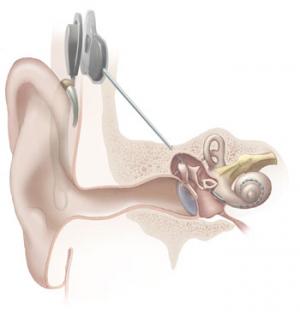Protein glue shows potential for use with biomaterials

Improving cell adhesion to biomaterials is crucial for the development of implanted neural prostheses such as cochlear implants. Copyright : Wikimedia
Researchers at the University of Milan in Italy have shown that a synthetic protein called AGMA1 has the potential to promote the adhesion of brain cells in a laboratory setting. This could prove helpful in improving cell adhesiveness to biomaterials.
Isolating nerve cells from their original organism and culturing them in the laboratory has long been used as a method to study brain metabolism. It has been challenging, however, to provide brain cell cultures with the necessary “adhesion promoters” that facilitate cell attachment, spreading, growth and morphological development.
Improving cell adhesion to biomaterials is also a major challenge in nerve tissue engineering and is crucial for the development of implanted neural prostheses, such as cochlear implants, and biosensors, such as blood glucose biosensors.
Coating the surfaces of negatively charged cell membranes with positively charged synthetic proteins promotes nerve adhesion and extension in laboratory settings. Most synthetic proteins, however, are toxic to living cells and thus need to be washed off before cell suspensions are spread onto a new plate. They are also unsuitable for applications that are used inside a living organism.
Within the central nervous system, extracellular matrix substances such as collagen and laminin promote the regeneration, differentiation, adhesion and migration of nerve fibers.
A protein sequence found in collagen and laminin has been identified as the minimum sequence that can mediate the adhesion of many cell types, including nerve cells.
AGMA1 is a basic synthetic protein that is biocompatible, water soluble, positively charged, and has a protein sequence similar to that found in collagen and laminin. It is much less toxic to living cells than conventionally used synthetic proteins. AGMA1 is also much easier to prepare on a large scale using relatively low-cost materials. As a result it is much cheaper.
University of Milan scientists tested the potential of AGMA1 to promote the adhesion, proliferation, and differentiation of primary brain cells in the laboratory.
Different primary cell types from rat brain were cultured on AGMA1, and the results compared with those of cells cultured under the same conditions on conventional substrates using other commonly used synthetic proteins. All experimental results showed that the performance of AGMA1 in this respect was comparable to that of conventional substrates.
For further information contact:
Dr Paolo Ferruti
Department of Chemistry
University of Milan
Milan, ITALY
E-mail: paolo.ferruti@unimi.it
Phone: +39-02-5031-4128
Associated links
Journal information
Sci. Technol. Adv. Mater. 15 (2014) 045007
Media Contact
All latest news from the category: Materials Sciences
Materials management deals with the research, development, manufacturing and processing of raw and industrial materials. Key aspects here are biological and medical issues, which play an increasingly important role in this field.
innovations-report offers in-depth articles related to the development and application of materials and the structure and properties of new materials.
Newest articles

Superradiant atoms could push the boundaries of how precisely time can be measured
Superradiant atoms can help us measure time more precisely than ever. In a new study, researchers from the University of Copenhagen present a new method for measuring the time interval,…

Ion thermoelectric conversion devices for near room temperature
The electrode sheet of the thermoelectric device consists of ionic hydrogel, which is sandwiched between the electrodes to form, and the Prussian blue on the electrode undergoes a redox reaction…

Zap Energy achieves 37-million-degree temperatures in a compact device
New publication reports record electron temperatures for a small-scale, sheared-flow-stabilized Z-pinch fusion device. In the nine decades since humans first produced fusion reactions, only a few fusion technologies have demonstrated…





















